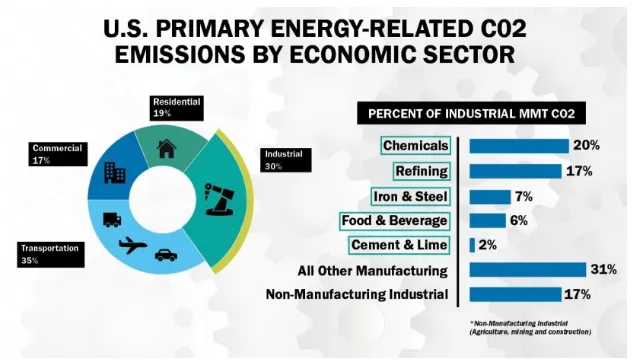
Reducing Industrial Emissions
The world relies on industrial activities for a wide range of products, materials and services. Petroleum refining, chemical manufacturing, and food and beverage production, are just a few examples. Emissions from industrial activities and sectors, including construction, manufacturing, and the electricity and heat utilized by the industry, constitute around one-third of global greenhouse gas emissions. These emission levels are the highest of any major economic sector. That’s why industrial decarbonization is the key to reducing global emissions and creating a more sustainable future.
Even without taking into account the indirect emissions from purchased electricity and heat, the industrial sector still constitutes around one-fifth of global GHG emissions. Three industries alone – cement, iron and steel, and plastics and chemicals – account for around 55% of industrial emissions. Plus, the 10 leading industries produce up to 90% of industrial emissions, according to data from Energy Innovation.
Organizations and businesses in the industrial industry can use a range of decarbonization technologies and intelligent strategies and policies to work towards achieving their net zero goals. They can also adopt lower-carbon manufacturing technologies without compromising their profitability or efficiency.
Some of the most promising policies designed for the sector include research and development support, carbon pricing, and industrial emissions standards and energy efficiency.
What is Meant by Industrial Emissions? Industrial Emissions Definition and Explanation
The industrial sector produces a vast range of raw materials and goods that are used daily on a global scale. A concise industrial emissions definition explains these emissions as greenhouse gas emissions produced during industrial production processes. These can be divided into two key categories. Direct emissions are emitted at production facilities. Indirect emissions are emitted off-site, but can still be associated with a production facility’s use of resources and energy.
Direct emissions are those produced by burning fuel for heat or power, through leaks from industrial equipment and processes, and via chemical reactions. Most of these emissions are produced through the use of fossil fuels. The remainder is produced by leaks from petroleum and natural gas systems and chemical reactions that take place during metal, chemical, and mineral production.
Indirect emissions steam from the burning of fossil fuels at power plants to produce electricity, which industrial facilities use to power their equipment and premises. According to the EPA, direct industrial greenhouse gas emissions constituted 24% of the US’s total GHG emissions in 2020. This makes industrial emissions the third largest contributor in the nation, after the electricity and transportation industries.
Industrial decarbonization is a primary solution to the issue of rising industrial emissions. Industrial decarbonization refers to the phasing out of GHG emissions from every aspect of industrial processing and production without affecting the sector’s essential contributions to global economic growth and prosperity. According to data from the Advanced Manufacturing Office, the sub-sectors most in need of decarbonization include chemical manufacturing (which produces 20% of industrial CO2 emissions), petroleum refining (17%), steel and iron (7%), food and beverage (6%), and cement (2%).

How Can Industries Reduce Their Emissions?
There are many ways that industrial sectors and organizations can reduce their direct and indirect emissions. However, the key starting point for organizations to understand the potential impact of mitigation projects is developing a GHG Inventory.
Greenhouse gas inventories can serve as baselines. Industrial producers can use them to track increases and decreases in future emissions and implement carbon emission reduction strategies accordingly.
SINAI’s decarbonization platform offers full greenhouse gas inventory automation to enable more flexible data collection, customization of emission factors, and complete engagement of value chains. Our inventories allow you to sort, aggregate and filter emissions data, and compare sources of emissions and resource consumption data. With our software, you can easily identify patterns, trends, and hot spots to produce auditable and transparent calculations.
Once an inventory is built and a company has projectied its emissions baseline to compare mitigation progress against, companies can evaluate these common abatement projects:
Improved energy efficiency
Improving the efficiency of equipment, motors, and heating is crucial for reducing industrial carbon emissions. These factors account for 30% of the industry’s total energy usage across various sub-sectors. New digital technologies and the Internet of Things connected smart equipment have created opportunities to enhance energy efficiency and implement automation. According to one study, this could reduce global CO2 emissions by 15% by 2030. Combined heat and power systems (CHPs) could also reduce energy consumption across industrial sectors.

Using new manufacturing techniques
Improvements in manufacturing processes can reduce energy requirements and GHG emissions. Switching raw materials and inputs may also lower emissions in some cases. Such as using fly ash from coal power plants instead of high-emitting clinker in the production of cement, for instance.
Switching to lower-emitting fuels
Electrifying the industrial sector to a larger degree and using decarbonized pipeline gas can lower emissions. On-site fossil fuel burning is the primary direct source of emissions. Energy-efficient solutions must be implemented to ensure that industrial producers are lowering their direct emissions sources. Rather than converting them into indirect emissions sources by consuming excess energy through electrification.
Developing an internal carbon price
Internal carbon pricing enables industrial organizations to measure financial impacts and progress against carbon reduction targets using robust scenario analysis. A carbon pricing tool like SINAI aids businesses to quantify targets, emission gaps, and carbon budgets. All while implementing pricing mechanisms based on an optimal business approach.
Carbon capture, utilization and storage
Industrial carbon capture, utilization and storage (CCUS) can play a major role in reducing GHG emissions. CCUS technologies can be used in cement, chemicals, fertilizer, steel, hydrogen and refining plants, and are quickly becoming more widely available to private sector businesses.
Decarbonizing the Industrial Industry
Following industrial emissions directives and science-based guidelines is the key to reducing emissions across the global industrial sector and all of its sub-sectors. Innovative technological solutions like SINAI are crucial for decarbonizing this industry in ways that align with the Science Based Targets initiative’s guidelines and principles.
Use our enterprise software platform to measure, analyze, price and reduce emissions to reach your organization’s emissions reduction or net zero goals.











